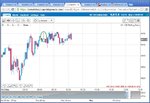LauraRomans
Member
- Messages
- 68
- Likes
- 2
Do you scalp?
What is you profit/stop loss ratio?
For example I use a stop that has a loss 4x greater than the profit limit. A TIMED stopped takes me 50% of the time so the average profit and aferage loss per trade are almost equal. If I can be right 75% of the time then Im in the black.
Does this seem out of the box? Bad thinking? Too risky? Leaving profit on the table? Etc.
ALL comments are welcomed!
What is you profit/stop loss ratio?
For example I use a stop that has a loss 4x greater than the profit limit. A TIMED stopped takes me 50% of the time so the average profit and aferage loss per trade are almost equal. If I can be right 75% of the time then Im in the black.
Does this seem out of the box? Bad thinking? Too risky? Leaving profit on the table? Etc.
ALL comments are welcomed!


